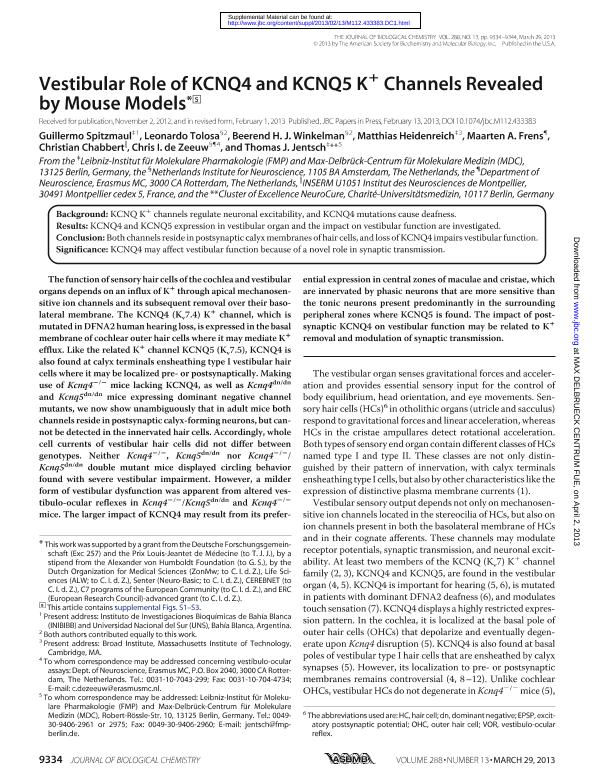Mostrar el registro sencillo del ítem
dc.contributor.author
Spitzmaul, Guillermo Federico

dc.contributor.author
Tolosa, Leonardo
dc.contributor.author
Winkelman, Beerend H. J.
dc.contributor.author
Heidenreich, Matthias
dc.contributor.author
Frens, Maartens
dc.contributor.author
Chabbert, Christian
dc.contributor.author
de Zeeuw, Chris I.
dc.contributor.author
Jentsch, Thomas J.
dc.date.available
2016-03-01T15:58:33Z
dc.date.issued
2013-03
dc.identifier.citation
Spitzmaul, Guillermo Federico; Tolosa, Leonardo; Winkelman, Beerend H. J.; Heidenreich, Matthias; Frens, Maartens; et al.; Vestibular role of KCNQ4 and KCNQ5 K+ channels revealed by mouse models; American Society For Biochemistry And Molecular Biology; Journal Of Biological Chemistry; 288; 13; 3-2013; 9334-9344
dc.identifier.issn
0021-9258
dc.identifier.uri
http://hdl.handle.net/11336/4553
dc.description.abstract
The function of sensory hair cells of the cochlea and vestibular organs depends on an influx of K+ through apical mechanosensitive ion channels and its subsequent removal over their basolateral membrane. The KCNQ4 (Kv7.4) K+ channel, which is mutated in DFNA2 human hearing loss, is expressed in the basal membrane of cochlear outer hair cells (OHCs) where it may mediate K+ efflux. Like the related K+ channel KCNQ5 (Kv7.5), KCNQ4 is also found at calyx terminals ensheathing type I vestibular hair cells where it may be localized pre- or postsynaptically. Making use of Kcnq4-/- mice lacking KCNQ4, as well as Kcnq4dn/dn and Kcnq5dn/dn mice expressing dominant negative channel mutants, we now show unambiguously that in adult mice both channels reside in postsynaptic calyx-forming neurons, but cannot be detected in the innervated hair cells. Accordingly whole-cell currents of vestibular hair cells did not differ between genotypes. Neither Kcnq4-/-, Kcnq5dn/dn nor Kcnq4-/-/Kcnq5dn/dn double mutant mice displayed circling behavior found with severe vestibular impairment. However, a milder form of vestibular dysfunction was apparent from altered vestibulo-ocular reflexes in Kcnq4-/-/Kcnq5dn/dn and Kcnq4-/- mice. The larger impact of KCNQ4 may result from its preferential expression in central zones of maculae and cristae, which are innervated by phasic neurons that are more sensitive than the tonic neurons predominantly present in the surrounding peripheral zones where KCNQ5 is found. The impact of postsynaptic KCNQ4 on vestibular function may be related to K+ removal and modulation of synaptic transmission.
dc.format
application/pdf
dc.language.iso
eng
dc.publisher
American Society For Biochemistry And Molecular Biology

dc.rights
info:eu-repo/semantics/openAccess
dc.rights.uri
https://creativecommons.org/licenses/by-nc-sa/2.5/ar/
dc.subject
M Currents
dc.subject
Calyx Terminal
dc.subject
Utricle
dc.subject
Gene Disruption
dc.subject.classification
Neurociencias

dc.subject.classification
Medicina Básica

dc.subject.classification
CIENCIAS MÉDICAS Y DE LA SALUD

dc.title
Vestibular role of KCNQ4 and KCNQ5 K+ channels revealed by mouse models
dc.type
info:eu-repo/semantics/article
dc.type
info:ar-repo/semantics/artículo
dc.type
info:eu-repo/semantics/publishedVersion
dc.date.updated
2016-03-30 10:35:44.97925-03
dc.journal.volume
288
dc.journal.number
13
dc.journal.pagination
9334-9344
dc.journal.pais
Estados Unidos

dc.journal.ciudad
Bethesda
dc.description.fil
Fil: Spitzmaul, Guillermo Federico. Leibniz Institut Fur Molekulare Pharmakologie; Alemania. Consejo Nacional de Investigaciones Científicas y Técnicas. Centro Científico Tecnológico Bahía Blanca. Instituto de Investigaciones Bioquímicas Bahía Blanca (i); Argentina
dc.description.fil
Fil: Tolosa, Leonardo. Netherlands Institute For Neuroscience; Países Bajos
dc.description.fil
Fil: Winkelman, Beerend H. J.. Netherlands Institute For Neuroscience; Países Bajos
dc.description.fil
Fil: Heidenreich, Matthias. Leibniz_Institut Fur Molekulare Pharmakologie (Fmp) ; Alemania
dc.description.fil
Fil: Frens, Maartens. Department Of Neurosciences, Erasmus; Países Bajos
dc.description.fil
Fil: Chabbert, Christian. Institut Des Neurosciences De Montpellier; Francia
dc.description.fil
Fil: de Zeeuw, Chris I.. Netherlands Institute For Neuroscience; Países Bajos
dc.description.fil
Fil: Jentsch, Thomas J.. Charité-Universitätsmedizin. Cluster of Excellence NeuroCure; Alemania
dc.journal.title
Journal Of Biological Chemistry

dc.relation.alternativeid
info:eu-repo/semantics/altIdentifier/url/http://www.ncbi.nlm.nih.gov/pmc/articles/PMC3611004/
dc.relation.alternativeid
info:eu-repo/semantics/altIdentifier/doi/http://dx.doi.org/10.1074/jbc.M112.433383
dc.relation.alternativeid
info:eu-repo/semantics/altIdentifier/url/http://www.jbc.org/content/288/13/9334
dc.relation.alternativeid
info:eu-repo/semantics/altIdentifier/issn/0021-9258
Archivos asociados
